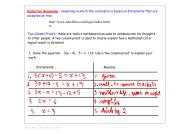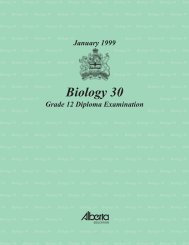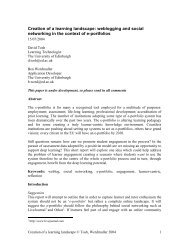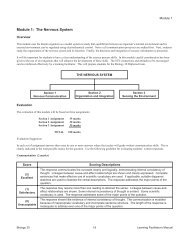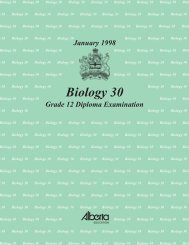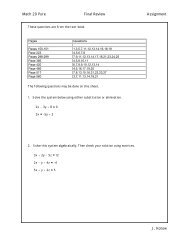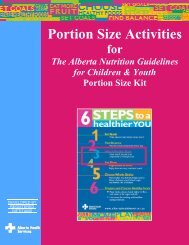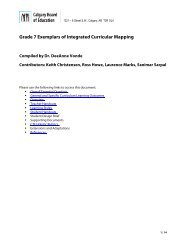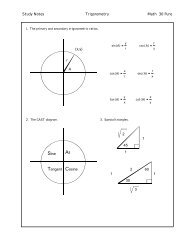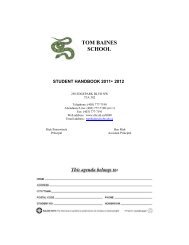Biology 30 - Calgary Board of Education
Biology 30 - Calgary Board of Education
Biology 30 - Calgary Board of Education
You also want an ePaper? Increase the reach of your titles
YUMPU automatically turns print PDFs into web optimized ePapers that Google loves.
Copyright 1998, the Crown in Right <strong>of</strong> Alberta, as represented by the Minister <strong>of</strong> <strong>Education</strong>, Alberta<strong>Education</strong>, Student Evaluation Branch, 11160 Jasper Avenue, Edmonton, Alberta T5K 0L2. All rightsreserved. Additional copies may be purchased from the Learning Resources Distributing Centre.Special permission is granted to Alberta educators only to reproduce, for educational purposes and ona non-pr<strong>of</strong>it basis, parts <strong>of</strong> this examination that do not contain excerpted material only after theadministration <strong>of</strong> this examination.Excerpted material in this examination shall not be reproduced without the written permission <strong>of</strong> theoriginal publisher (see credits page, where applicable.)
June 1998<strong>Biology</strong> <strong>30</strong>Grade 12 Diploma ExaminationDescriptionTime: 2.5 h. You may take anadditional 0.5 h to complete theexamination.This is a closed-book examinationconsisting <strong>of</strong>• 48 multiple-choice and 8 numericalresponsequestions, <strong>of</strong> equal value,worth 70% <strong>of</strong> the examination• 2 written-response questions, <strong>of</strong> equalvalue, worth <strong>30</strong>% <strong>of</strong> the examination• 80 total possible marks, worth 100% <strong>of</strong>the examinationThis examination contains sets<strong>of</strong> related questions.A set <strong>of</strong> questions may containmultiple-choice and/or numericalresponseand/or written-responsequestions.Tear-out data pages are included nearthe back <strong>of</strong> this booklet.The blank perforated pages at the back<strong>of</strong> this booklet may be torn out and usedfor your rough work. No marks will begiven for work done on the tear-outpages.Instructions• Fill in the information required on theanswer sheet and the examinationbooklet as directed by the presidingexaminer.• You are expected to provide your ownscientific calculator.• Use only an HB pencil for themachine-scored answer sheet.• If you wish to change an answer, eraseall traces <strong>of</strong> your first answer.• Consider all numbers used in theexamination to be the result <strong>of</strong> ameasurement or observation.• Do not fold the answer sheet.• The presiding examiner will collectyour answer sheet and examinationbooklet and send them to Alberta<strong>Education</strong>.• Now turn this page and read thedetailed instructions for answeringmachine-scored and written-responsequestions.
Multiple Choice• Decide which <strong>of</strong> the choices bestcompletes the statement or answersthe question.• Locate that question number on theseparate answer sheet provided andfill in the circle that corresponds toyour choice.ExampleThis examination is for thesubject <strong>of</strong>A. biologyB. physicsC. chemistryD. scienceAnswer SheetA B C DNumerical Response• Record your answer on the answersheet provided by writing it in theboxes and then filling in thecorresponding circles.• If an answer is a value between 0 and 1(e.g., 0.25), then be sure to record the 0before the decimal place.• Enter the first digit <strong>of</strong> your answerin the left-hand box and leave anyunused boxes blank.ExamplesCalculation Question and SolutionThe average <strong>of</strong> the values 21.0, 25.5, and 24.5is _________.(Round and record your answer to threesignificant digits in the numerical-responsesection <strong>of</strong> the answer sheet.)Average = (21.0 + 25.5 + 24.5)/3= 23.666…= 23.7Record 23.7 on theanswer sheet 2 3 . 7. .0 0 0 01 1 1 12 2 2 23 3 3 34 4 4 45 5 5 56 6 6 67 7 7 78 8 8 89 9 9 9ii
Written ResponseCorrect-Order Question and SolutionWhen the following subjects are arranged inalphabetical order, the order is ______.(Record all four digits in the numerical-responsesection <strong>of</strong> the answer sheet.)1 physics2 chemistry3 biology4 scienceAnswer 3214Record 3214 on theanswer sheet 3 2 1 4. .0 0 0 01 1 1 12 2 2 23 3 3 34 4 4 45 5 5 56 6 6 67 7 7 78 8 8 89 9 9 9• Write your answers in the examinationbooklet as neatly as possible.• For full marks, your answers must bewell organized and address all the mainpoints <strong>of</strong> the question.• Relevant scientific, technological, and/orsocietal concepts and examples must beidentified and explicit.• Descriptions and/or explanations <strong>of</strong>concepts must be correct and reflectpertinent ideas, calculations, andformulas.• Your answers should be presented in awell-organized manner using completesentences, correct units, and significantdigits where appropriate.Selection Question and SolutionThe birds in the following list are numbered ______.(Record your answer in lowest-to-highest numericalorder in the numerical-response section <strong>of</strong> theanswer sheet.)1 dog2 sparrow3 cat4 robin5 chickenAnswer 245Record 245 on theanswer sheet 245. .0 0 0 01 1 1 12 2 2 23 3 3 34 4 4 45 5 5 56 6 6 67 7 7 78 8 8 89 9 9 9iii
While animals interact with their external environment, their nervous and endocrinesystems maintain internal equilibrium. The study <strong>of</strong> organisms and <strong>of</strong> disease processeshas helped extend our knowledge <strong>of</strong> these systems.Use the following information to answer the next question.The symptoms <strong>of</strong> Alzheimer’s disease gradually appear as affected individuals age. Onesymptom <strong>of</strong> Alzheimer’s disease is a loss <strong>of</strong> memory. Studies have shown that theadministration <strong>of</strong> the hormone estrogen to female patients with Alzheimer’s diseasedramatically improved their memory.—from <strong>Calgary</strong> Herald, 19961. It appears that the hormone estrogen has an effect on theA. cerebrumB. cerebellumC. hypothalamusD. medulla oblongataUse the following information to answer the next question.After a head injury, a mountain biker was assessed by a doctor. One <strong>of</strong> the tests the doctor didwas to gently tap just below her kneecap. Also, he shone a light into each <strong>of</strong> her eyes andmade observations. In both tests, he was trying to quickly rule out any neurological damage.2. Assume that the biker’s nervous system was not injured and that the biker’s bodyresponded in a normal way to the gentle tap. The neurological pathway that wasfollowed when this response was elicited wasA. receptor, sensory neuron, interneuron, motor neuron, effectorB. effector, sensory neuron, interneuron, motor neuron, receptorC. receptor, motor neuron, interneuron, sensory neuron, effectorD. effector, motor neuron, interneuron, sensory neuron, receptor1
Use the following information to answer the next question.Diving improperly into a swimming pool or into a lake may cause injuries that damage thespinal cord. The victims <strong>of</strong> these injuries <strong>of</strong>ten suffer loss <strong>of</strong> the sensation <strong>of</strong> heat and touchon the skin and paralysis <strong>of</strong> muscles below the site <strong>of</strong> the injury.3. Paralysis <strong>of</strong> muscles below the site <strong>of</strong> a spinal cord injury is <strong>of</strong>ten permanentbecause neurons in the grey matter <strong>of</strong> the spinal cord all lack aA. nucleusB. dendriteC. cell bodyD. neurilemmaUse the following information to answer the next question.Sections <strong>of</strong> Axons+ + + + + + + + + + + + + + +– – – – – – – – – – – – – – –W+ + + + + + + + – – – – – – – –– – – – – – – + + + + + + + +Y+ + + + + + – – – – – + + + + +– – – – – + + + + + – – – – –X– – – – – – – – – – – – – – – –+ + + + + + + + + + + + + + +Z4. The resting axon is labelledA. WB. XC. YD. Z2
Use the following information to answer the next question.Neuron 1Synaptic TransmissionXYNeuron 2W5. Destruction <strong>of</strong> the synaptic vesicles <strong>of</strong> Neuron 1 willA. block the nerve impulse at WB. cause X to be constantly stimulatedC. prevent depolarizations from occurring at YD. result in the action <strong>of</strong> cholinesterase in Neuron 23
Use the following information to answer the next question.Bats emit a high-frequency “chirp” as they fly. They listen for the reflection <strong>of</strong> this sound <strong>of</strong>f<strong>of</strong> moths, their food. By interpreting the time it takes for the sound to return, they caneffectively catch moths, even in total darkness.—from Curtis, 1983Numerical Response01. Assume that the ear structure <strong>of</strong> bats is similar to that <strong>of</strong> humans. What pathway wouldthese “chirp” sound waves take through the ear to be detected by the temporal lobe?Structures <strong>of</strong> the Ear1 Semicircular canals2 Organ <strong>of</strong> Corti3 Eustachian tube4 Tympanic membrane5 Auditory canal6 Ossicles(Record your four-digit answer in the numerical-response section <strong>of</strong> the answer sheet.)Answer: _____ _____ _____ _____4
Use the following information to answer the next two questions.Cross-section <strong>of</strong> a Normal EyeGlaucoma is a vision defect that occurs where there is a blockage <strong>of</strong> the ducts draining theaqueous humour <strong>of</strong> the eye. Pressure builds in the eye, and sensory information cannot berelayed to the brain by the optic nerve. The increased pressure may lead to blindness due todamaged optic nerves.—from Taber, 19896. When glaucoma occurs, the part <strong>of</strong> the cerebrum that does not receive visualinformation is theA. frontal lobeB. parietal lobeC. occipital lobeD. temporal lobeUse the additional information to answer the next question.Retinal detachment is a disorder <strong>of</strong> the eye that is closely related to aging. It may also be theresult <strong>of</strong> a direct injury to the eye. In this disorder, sections <strong>of</strong> the retina become separatedfrom the layer behind it. Fluid fills the resulting spaces.—from Taber, 19897. Blindness due to optic nerve damage and blindness due to retinal detachment aresimilar because they bothA. involve damaged receptorsB. affect blood flow to the eyeC. involve damaged occipital lobesD. affect nerve impulse transmission to the brain5
Use the following information to answer the next four questions.Organs and Endocrine Glands12345678. The gland that is directly stimulated by the nervous system to secrete hormones isthe structure labelledA. 2B. 3C. 4D. 59. The structure that produces only hormones is labelledA. 1B. 2C. 5D. 610. A target organ for aldosterone is the structure labelledA. 3B. 5C. 6D. 76
11. A patient is suffering from weight gain, sluggishness, and dry skin. The patient isinjected with a tracer, radioactive iodine, to identify the structure responsible forthese symptoms. The tracer would most likely accumulate in the structure labelledA. 1B. 2C. 4D. 712. When the hypothalamus fails to produce ADH, the physiological effect that is mostlikely isA. muscle spasmsB. loss <strong>of</strong> memoryC. decreased breathing rateD. increased urine production7
Use the following information to answer the next question.Example <strong>of</strong> a Negative Feedback LoopStructure 1MonitorStructure 2 Structure 3(–)13. If the physiological factor influencing this negative feedback loop were themetabolic rate, then 1, 2, and 3, respectively, would be theA. hypothalamus, pituitary, and thyroidB. thyroid, hypothalamus, and pituitaryC. pituitary, thyroid, and hypothalamusD. pituitary, hypothalamus, and thyroid14. The response to increased glucose levels in the blood is the conversion <strong>of</strong> glucose toglycogen. This response is the result <strong>of</strong> the secretion <strong>of</strong>A. insulin by the adrenal medullaB. glucagon by the adrenal medullaC. insulin by the islets <strong>of</strong> LangerhansD. glucagon by the islets <strong>of</strong> Langerhans15. While playing a vigorous game <strong>of</strong> basketball, a person’s overall rate <strong>of</strong> metabolismincreases. Which two hormone levels rise so that blood glucose levels meet theneeds <strong>of</strong> the increased metabolic rate?A. Cortisol and ADHB. Steroids and HGHC. Insulin and acetylcholineD. Epinephrine and glucagon8
Use the following information to answer the next two questions.HGH is a protein. Biosynthetic HGH is used in the treatment <strong>of</strong> Turner syndrome, a disorderoccurring in females as a result <strong>of</strong> nondisjunction; the sex chromosome complement is XOinstead <strong>of</strong> the normal XX. Untreated females with Turner syndrome grow only to the height <strong>of</strong>an average ten-year-old.—from Leger, 199416. In humans, HGH directly stimulates theA. gonadsB. adrenal glandsC. muscles and peripheral nervesD. long bones and skeletal muscles17. Why might nondisjunction produce more serious effects on the population if itwere present in gametes produced by a female rather than in gametes producedby a male?A. An egg (ovum) is larger than a sperm.B. Fewer eggs (ova) are produced than sperm.C. An egg mother cell (oogonium) divides twice but a sperm mother cell(spermatogonium) divides only once.D. An egg mother cell (oogonium) divides equally but a sperm mother cell(spermatogonium) divides unequally.9
Reproductive processes may be affected by disease, the environment, or the use <strong>of</strong>technology.Use the following information to answer the next two questions.18. Structure X representsA. an ovaryB. a follicleC. an oocyteD. a corpus luteum19. A reasonable interpretation <strong>of</strong> the graph and drawings would be that FSH isbeginning to increase at dayA. 10B. 14C. 21D. 2810
Use the following information to answer the next question.Reproductive System <strong>of</strong> aHuman MaleReproductive System <strong>of</strong> aHuman Female51267348Numerical Response02. The target organs for FSH in the male and the female are labelled, respectively,__________ and __________.(Record your two-digit answer in the numerical-response section <strong>of</strong> the answer sheet.)Answer: __________20. Birth control pills prevent pregnancy. One form <strong>of</strong> birth control pill works bymimicking some characteristics <strong>of</strong> pregnancy. A direct result <strong>of</strong> using this birthcontrol pill is that during most <strong>of</strong> the menstrual cycleA. increased and sustained levels <strong>of</strong> LH are released from the pituitaryB. increased and sustained levels <strong>of</strong> FSH are released from the pituitaryC. progesterone and estrogen levels are maintained at a relatively low levelD. progesterone and estrogen levels are maintained at a relatively high level21. Which <strong>of</strong> the following statements about normal human fertilization is correct?A. Fertilization occurs in the uterus <strong>of</strong> the woman.B. Fertilization occurs in a simple, one-step process.C. Fertilization involves the use <strong>of</strong> enzymes by sperm.D. Fertilization involves the replication <strong>of</strong> chromosomes.11
22. Which hormone induces uterine contractions?A. RelaxinB. ProlactinC. OxytocinD. ProgesteroneUse the following information to answer the next question.Events That Occur When Lactation is Initiated by theFeeding Action <strong>of</strong> a Baby1 Release <strong>of</strong> oxytocin into the blood2 Transmission <strong>of</strong> nerve impulses to the hypothalamus3 Contraction <strong>of</strong> smooth muscle in the gland4 Stimulation <strong>of</strong> sensory nerve endings in the breastNumerical Response03. The sequence <strong>of</strong> events that occurs when lactation is initiated by a baby is __________.(Record your four-digit answer in the numerical-response section <strong>of</strong> the answer sheet.)Answer: _____ _____ _____ _____12
The study <strong>of</strong> cell division, chromosome composition, and the structure and function<strong>of</strong> DNA increases understanding <strong>of</strong> growth, genetic continuity, and diversity <strong>of</strong>organisms.Use the following information to answer the next two questions.OrganismChromosome Number (2n)Horse 66Dog 78Cat 38Human 4623. Which <strong>of</strong> the following statements about cell types and chromosome numbers is correct?A. The ovum <strong>of</strong> a horse contains 66 chromosomes.B. A somatic cell <strong>of</strong> a cat contains 76 chromosomes.C. The spermatid <strong>of</strong> a dog contains 39 chromosomes.D. A somatic cell <strong>of</strong> a human contains 23 chromosomes.Use the additional information to answer the next question.The Life Cycle <strong>of</strong> the HorseProcess 2EmbryoProcess 3ZygoteReproductiveorgansProcess 1GametesProcess 424. Which process illustrates reduction division, as in spermatogenesis?A. Process 1B. Process 2C. Process 3D. Process 413
Use the following information to answer the next question.Some Events That Occur During Cell Division1 Centromeres divide2 Cytokinesis occurs3 Identical cells are produced4 DNA is replicated5 Haploid cells are produced6 Spindle fibres formNumerical Response04. Four events that occur in both human asexual and sexual cell reproduction arerepresented by numbers __________.(Record your four-digit answer in lowest-to-highest numerical order in the numerical-responsesection <strong>of</strong> the answer sheet.)Answer: _____ _____ _____ _____25. In a human cell cycle, the event that occurs before mitosis begins and the event thatoccurs at or near the completion <strong>of</strong> mitosis are, respectively,A. crossing over and synapsisB. cytokinesis and crossing overC. replication <strong>of</strong> DNA and synapsisD. replication <strong>of</strong> DNA and cytokinesis14
Use the following information to answer the next question.During his study <strong>of</strong> genetics, Gregory Mendel cross-pollinated many pea plants. He recordedthe number and types <strong>of</strong> <strong>of</strong>fspring produced and applied his knowledge <strong>of</strong> mathematics tocreate explanations for his observations. He hypothesized that factors are inherited separatelyand proposed the law <strong>of</strong> segregation.26. The modern-day interpretation <strong>of</strong> Mendel’s law <strong>of</strong> segregation is thatA. alleles are expressed independently during mitosisB. alleles are expressed independently during meiosisC. paired alleles separate during mitosis and are distributed into different gametesD. paired alleles separate during meiosis and are distributed into different gametesUse the following information to answer the next two questions.In cattle, hornless or polled (P) is dominant over the horned (p) condition. This is an autosomaltrait. The semen <strong>of</strong> a polled bull is used to artificially inseminate three cows. Cow 1 (horned)produces a horned calf, cow 2 (polled) produces a horned calf, and cow 3 (polled) produces apolled calf.27. Which <strong>of</strong> the cattle must have a heterozygous genotype for this trait?A. Cow 2 and calf 2B. Cow 3 and calf 3C. The polled bull and cow 1D. The polled bull and cow 228. Which <strong>of</strong> the above cattle could have two possible genotypes?A. Cow 1B. Cow 2C. Cow 3D. The polled bull15
Use the following information to answer the next two questions.Four babies were born in a hospital on the same day. Due to a mix-up at the hospital, therewas some confusion as to the identity <strong>of</strong> the babies.Mother FatherParents 1 Type A Type OParents 2 Type AB Type BParents 3 Type AB Type OParents 4 Type O Type B29. Which <strong>of</strong> the above parents could have a baby with blood type O?A. Parents 1 and 3B. Parents 1 and 4C. Parents 2 and 3D. Parents 2 and 4<strong>30</strong>. The predicted phenotypic ratio for the children <strong>of</strong> parents 3 isA.12 type A and 1 2 type BB.12 type AB and 1 2 type OC.14 type A, 1 2 type O, and 1 4 type BD.14 type A, 1 4 type B, 1 4 type AB, and 1 4 type O16
Use the following information to answer the next two questions.Assume that there are two gene pairs involved in determining eye colour: one codes forpigment in the front <strong>of</strong> the iris and the other codes for pigment in the back <strong>of</strong> the iris.If the genotype isthen the eye colour isAABB …………………………….…. black–brownAABb …………………………….…. dark brownAAbb …………………………….…. brownAaBB …………………………….…. brown–green fleckedAaBb …………………………….…. light brownAabb …………………………….…. grey–blueaaBB …………………………….…. greenaaBb …………………………….…. dark blueaabb …………………………….…. light blue—from Audesirk, 199631. A man has grey–blue eyes and a woman has green eyes. Which eye colourphenotypes would be possible for children born to this man and woman?A. Grey–blue and greenB. Dark blue and brownC. Light brown and dark blueD. Brown–green flecked and light blueNumerical Response05. If one parent has light brown eyes and the other has dark brown eyes, what is theprobability that they would have an <strong>of</strong>fspring with grey–blue eyes?(Record your answer as a percentage to three digits in the numerical-response section <strong>of</strong> theanswer sheet.)Answer: __________%17
Use the following information to answer the next three questions.Scientists have identified a genetic condition that apparently makes some men prone toimpulsive, violent behaviour. A pedigree was drawn highlighting the violent members <strong>of</strong> aparticular family, It appeared, from the pedigree, that men who displayed this violentbehaviour inherited this condition from their mothers, not their fathers. Further evidenceshowed that this was the mode <strong>of</strong> inheritance.—from Richardson, 199332. The inheritance pattern described indicates that this condition isA. X-linkedB. Y-linkedC. autosomalD. codominant33. Which <strong>of</strong> the following pedigrees is not possible for the above condition?(Note: Carriers have not been identified.)A.B.C.D.18
Use the additional information to answer the next question.Researchers found that the allele that caused violent behaviour was situated on a chromosome ina region that codes for an enzyme responsible for breaking down neurotransmitters in the brain.—from Richardson, 199334. The substance affected by the genetic defect could beA. ACTHB. acetylcholineC. cholinesteraseD. norepinephrineUse the following information to answer the next two questions.Two alleles (H B and H N ) exist for the pattern baldness gene. The H B allele is dominant in menbut recessive in women. The H N (normal) allele is dominant in females but recessive in males.A single H B allele seems to cause pattern baldness only in the presence <strong>of</strong> the level <strong>of</strong>testosterone normally found in adult males. Males will develop pattern baldness with thegenotypes H B H N or H B H B ; whereas, for females to develop pattern baldness, they must inherittwo H B alleles. It appears that testosterone destroys or inhibits the production <strong>of</strong> an enzymenecessary for hair growth in the hair follicle.—from H<strong>of</strong>fman and Lingna, 199535. The difference in expression <strong>of</strong> pattern baldness in women and men results from thepattern baldness gene’s beingA. X-linkedB. Y-linkedC. independent <strong>of</strong> hormonal balanceD. influenced by the level <strong>of</strong> testosterone36. Parents who do not display pattern baldness have a son who exhibited patternbaldness by the age <strong>of</strong> thirty. If they also have a daughter, she hasA. no chance <strong>of</strong> going bald, as the H B H B genotype is not possibleB. no chance <strong>of</strong> going bald, as the H B H N genotype is not possibleC. a 1 in 3 chance <strong>of</strong> going bald, as the H B H N genotype is possibleD. a 1 in 2 chance <strong>of</strong> going bald, as the H B H B genotype is possible19
Use the following information to answer the next question.In Drosphila (fruit flies), the genes for pink eyes, rough eyes, curled wings, and hairless bristles arelocated on chromosome 3.GenesCrossover Frequency pink eyes and hairless bristles 21.5 hairless bristles and curled wings 19.5 rough eyes and curled wings 41.1 pink eyes and rough eyes 43.1 rough eyes and hairless bristles 21.6LegendPink eyes – 1Rough eyes – 2Curled wings – 3Hairless bristles – 4—from Griffiths, 1993Numerical Response06. Use the legend to indicate the order <strong>of</strong> these genes along a chromosome.(Record your four-digit answer in the numerical-response section <strong>of</strong> the answer sheet.)Answer: _____ _____ _____ _____(There are two possible ways <strong>of</strong> recordingthe answer; either will be acceptable.)Numerical Response07. In a large population <strong>of</strong> randomly breeding Drosphila, 1% <strong>of</strong> the populationexhibits burgundy eye colour, an autosomal recessive trait. According to theHardy–Weinberg equilibrium, what percentage <strong>of</strong> the population is expectedto be heterozygous?(Record your answer as a whole number percentage, in the numerical-response section <strong>of</strong> theanswer sheet.)Answer: __________%20
Use the following information to answer the next question.Small Segment <strong>of</strong> DNAComplementary Segment <strong>of</strong> RNA11111222224547686845333331111137. If structure 4 is adenine, then structure 8 isA. uracilB. adenineC. thymineD. cytosine21
Use the following information to answer the next question.The DNA sense strand shown below is thought to contain the genetic code for part <strong>of</strong> an enzymethat speeds up the breakdown <strong>of</strong> alcohol in the liver. (Read the DNA beginning at the left.)– A – A – G – G – G – C – C – T – T – A – T – C –38. Which amino acid sequence would be found in a polypeptide that is produced usingthe coded information in the above DNA sense strand?A. Leucine – glycine – glutamateB. Phenylalanine – proline – glutamateC. Leucine – glycine – glutamate – tyrosineD. Asparagine – proline – valine – methionineUse the following information to answer the next question.Between 50 000 and 100 000 genes are involved to build, run, and maintain a human body.Any one <strong>of</strong> these genes can mutate.If geneticists locate a harmful mutation, there is hope that one day they will be able to repairthe gene both in the affected individual and in his or her gametes.—from Turner, 199639. The technology to replace genes in cells <strong>of</strong> humans is calledA. gene cloningB. gene therapyC. carrier screeningD. DNA fingerprinting22
Use the following information to answer the next three questions.The polymerase chain reaction technique (PCR) makes it possible to produce a large number<strong>of</strong> copies <strong>of</strong> a specific DNA sequence in a relatively short time. When heated to 94ºC,double-stranded DNA molecules separate completely, forming two single strands. Later, afterthe temperature is lowered and with DNA polymerase present, complementary DNA strandsform. The process <strong>of</strong> heating and cooling can be repeated to produce as many copies <strong>of</strong> theDNA as is required.—from Klug and Cummings, 199740. If a DNA triplet is CTA, then the complementary DNA triplet isA. GAUB. GATC. CUAD. CTA41. PCR is similar to a process that normally occurs in cells prior to cell division. Therow that identifies the site and name <strong>of</strong> this process isRow Site ProcessA. nucleus replicationB. nucleus transcriptionC. cytoplasm replicationD. cytoplasm transcription42. Which enzymes would a geneticist use to cut DNA into fragments?A. Ligase enzymesB. RNA polymerasesC. DNA polymerasesD. Restriction enzymes23
Use the following information to answer the next four questions.In some humans, the liver is unable to produce the enzyme called fumarylacetoacetatehydrolase (FAH). Without this enzyme, the liver is damaged over time because <strong>of</strong> theaccumulation <strong>of</strong> the toxin succinylacetone. This toxin is produced through the impropermetabolism <strong>of</strong> amino acids. It has been found that livers damaged by succinylacetone actuallycontain small patches <strong>of</strong> undamaged cells. These cells produce FAH.Mice also suffer from liver damage caused by FAH deficiency. Researchers successfully usedthe following two methods to regenerate normal functioning livers in FAH-deficient mice.I. Researchers transplanted some healthy liver cells into the unhealthy livers <strong>of</strong> the mice.II. Researchers inserted normal genes into the damaged livers <strong>of</strong> the unhealthy mice.—from Travis, 199643. The most likely explanation for the success following the transplant <strong>of</strong> healthy cellsin mice is that the healthy cellsA. produced antibodies that repair the damaged cellsB. transferred FAH-producing genes to the damaged liverC. underwent meiosis more rapidly than the damaged cellsD. produced enough FAH enzyme to restore the function <strong>of</strong> the liver44. Which <strong>of</strong> the following statements about cells is demonstrated by this research?A. Genes control cell division in liver cells.B. Genes control the production <strong>of</strong> the FAH enzyme in cells.C. Liver cells in an individual are genetically identical to each other.D. Liver cells cannot regenerate themselves by the process <strong>of</strong> mitosis.24
45. The presence <strong>of</strong> patches <strong>of</strong> healthy cells in the damaged human livers may indicate thatA. enzymes are not normally coded for by genes in liver cellsB. liver cells in an individual can undergo genetic change and cell divisionC. liver cells migrated into the damaged livers from other places in the bodyD. enzymes are produced in various places in the body and then migrate into the liverNumerical Response08. The sequence <strong>of</strong> events that produces the enzyme FAH (a protein) in liver cellsis __________.1 tRNA transports amino acids to the ribosome2 information from DNA is used to form mRNA3 mRNA carries the message to the ribosome4 ribosome encounters a terminator (stop) codon(Record your four-digit answer in the numerical-response section <strong>of</strong> the answer sheet.)Answer: _____ _____ _____ _____25
Communities are made <strong>of</strong> populations, which may reach equilibrium or changeover time.Use the following information to answer the next two questions.Monarch butterflies lay their eggs on theleaves <strong>of</strong> milkweed plants. When the eggshatch, the larvae that emerge feed on theleaves, which are rich in cardiac glycosides.As larvae eat the leaves, these chemicals areincorporated into their tissues and remainthere through pupation and into the adultstage. In many animals, these chemicalsactivate a nerve centre that induces vomiting.Predators quickly learn to avoid the brightlystriped caterpillar and stunning black andorange butterfly. This affords protection tolarvae and adults.The viceroy butterfly closely resembles themonarch butterfly in shape and coloration. Itslife cycle does not include the milkweed plant;thus, it is safe for animals to eat.Monarch ButterflyViceroy Butterfly—from Postlethwait, 199246. Birds will not eat the viceroys if they haveA. tried to eat a viceroy and found it indigestibleB. eaten the larvae <strong>of</strong> the monarchs and recognize the tasteC. tasted the monarchs, which causes them to avoid viceroysD. consumed many monarchs and are being gradually poisoned26
47. To reduce predation, the timing <strong>of</strong> an adult viceroy’s emergence from its cocoonshould beA. after that <strong>of</strong> the monarch, to allow the predators to learn the warning signsB. simultaneous with that <strong>of</strong> the monarch, to ensure saturation <strong>of</strong> the food supplyC. before that <strong>of</strong> the monarch, to ensure that the predator’s search pattern avoids themD. simultaneous with that <strong>of</strong> the monarch, to allow the predators to learn both patterns48. Which natural disturbance would most likely initiate primary succession in acertain area?A. Land exposed when a glacier meltedB. An entire forest destroyed by diseaseC. Natural vegetation removed by a floodD. Grasslands burned by a lightning strike27
ForDepartmentUse OnlyUse the following information to answer the next question.As part <strong>of</strong> the Eastern Slopes Grizzly Bear Project, a research group was formed in 1994to assess the impact <strong>of</strong> human action on grizzly bears (Ursus arctos horribilis) in the BowRiver Watershed. This study area includes land in Central Alberta Rocky Mountainregions such as Banff National Park and Kananaskis Country. The project focuses onmapping grizzly bear habitat across park boundaries and examining the effects <strong>of</strong>development and land use on bear behaviour and survival.There are about 800 grizzly bears in Alberta <strong>of</strong> which about 60 roam within the 6 641 km 2<strong>of</strong> Banff National Park. There are no estimates for the entire Bow River Watershed studyarea. Grizzly bears live to between 10 and 20 years and begin to reproduce at an averageage <strong>of</strong> six years. Their litter size is about two cubs, once every three years. Cubs grow tobetween 150 and 400 kg.Findings <strong>of</strong> the Eastern Slopes Grizzly Bear Project have shown that although mountainparks have historically been considered major refuge areas for grizzly bears, only a smallarea <strong>of</strong> the critical habitat needed for raising cubs remains. Future development <strong>of</strong> RockyMountain townsites such as Banff, Lake Louise, and Canmore may further reduce therange <strong>of</strong> these bears. The range necessary for the survival <strong>of</strong> an individual adult male bearneeds to be approximately 2 000 km 2 /bear, however females roam over a considerablysmaller area.—from Marty, 1997Written Response – 15% (12 marks)(1 mark)1. a. Calculate the population density <strong>of</strong> grizzly bears in Banff National Park.(2 marks)b. Suppose that about one-quarter <strong>of</strong> the grizzly bear population inBanff National Park are adults, and about one-half <strong>of</strong> the adultsare males. Analyze the data on the grizzly population and rangesize in Banff National Park. Suppose that future developmentsrestricted grizzlies only to this area; then write a conclusionabout the survival ability <strong>of</strong> adult male bears in Banff NationalPark. (Show your calculations.)28
c. Grizzly bears have a relatively low biotic potential.ForDepartmentUse Only(3 marks)From the information provided about grizzly bears in Alberta, identifytwo factors that support this statement and explain how they contribute toa low biotic potential. Based on its biotic potential, classify the grizzlybear as an r-selected or K-selected species.Use the additional information to answer the next question.Studies show that grizzly bears avoid crossing highways. Female bears will notcross the Trans-Canada Highway at all, nor will they use wildlife crossings orunderpasses. As a result, traditional migratory corridors for the Eastern Slopesgrizzly bears are restricted, partially isolating them from other grizzly bearpopulations in neighbouring regions <strong>of</strong> the Rocky Mountains.—from Marty, 1997d. Predict the effect <strong>of</strong> the Trans-Canada Highway on the genetic diversity <strong>of</strong>the Eastern Slopes grizzly bear population. Explain your prediction.(2 marks)29
ForDepartmentUse Only(1 mark)e. Describe one technology that biologists would use in determining therange and migration routes <strong>of</strong> the Eastern Slope grizzly bears.Use the additional information to answer the next two questions.Reproductive Rate in a Population <strong>of</strong> Grizzlies in a Particular Area0.80.7Cubs per adult female/year0.60.50.40.<strong>30</strong>.20.140 50 60 70 80 90 100 110 120 1<strong>30</strong>Total population size in a particular areaNote: Assume that the grizzlies in Banff National Park are in an area <strong>of</strong> similar sizeto that represented by the graph.—from Smith, 1992(1 mark)f. i. Using the graph, predict the current reproductive rate <strong>of</strong> the grizzlybears within Banff National Park.(2 marks)ii.According to the graph, what is the relationship between the number<strong>of</strong> adult grizzly bears in a population and reproductive rate?Describe one factor that could account for this relationship.<strong>30</strong>
Use the following information to answer the next question.For 17 years, Elke and Mario Archangel, a Canadian couple living in New York City, tried tohave a baby. Elke was 52-years-old and had already experienced menopause when she finallybecame mother <strong>of</strong> twins.When Elke was 35-years-old, she was diagnosed with early stage cervical cancer and wastreated successfully. At that time, her doctor performed an operation to widen the opening <strong>of</strong>her cervix and advised her that she could still have children. Elke and Mario decided to havea baby; however, after two years they were still unsuccessful. They were sent to fertilityspecialists. On their advice, Elke began to take hormones to regulate and enhance herreproductive cycle. Later, she developed breast cancer and had both breasts removed. Shewas warned that continuing hormone therapy in an attempt to get pregnant could stimulatefurther growth <strong>of</strong> cancerous tumors, but the couple continued to try to have a baby. Afterapproximately 10 years <strong>of</strong> reproductive problems, Elke and Mario contacted adoptionagencies.Applications for adoption were refused because <strong>of</strong> their ages and Elke’s history <strong>of</strong> cancer.The couple were accepted into an in vitro fertilization program, but the program was notsuccessful. During this time, Elke went through menopause.A donor was then found to supply multiple eggs for another attempt at in vitro fertilization.The donor underwent hormone therapy to stimulate egg production. Elke was also givenhormones to prepare her to receive some pre-embryos, and on the second attempt, she becamepregnant. After all <strong>of</strong> the other expenses for treatment, Elke and Mario could no longer affordregular medical care during the pregnancy. In the eighth month <strong>of</strong> pregnancy, an emergencycaesarean section was performed. A girl affected with Down syndrome and a boy unaffectedby a genetic disorder were born.—from Fortino, 1994Written Response – 15% (12 marks)2. Write a unified essay that addresses aspects <strong>of</strong> fertility as introduced by Elke andMario’s story.Identify two possible causes <strong>of</strong> infertility in men or in women and explain howeach prevents or reduces the chance <strong>of</strong> pregnancy.Identify ethical or societal issues raised by this story and evaluate them. (Anevaluation includes at least one pro and one con.)Trisomy 21 is a cause <strong>of</strong> Down syndrome. Define what trisomy means andexplain how it occurs. A diagram may be used to enhance your answer.Describe a technological procedure that could have been used to determine thegenetic health <strong>of</strong> the fetuses before birth...............................................................................................................................................................................................................................................................................................................................................................................................................................................................................................................................31
..............................................................................................................................................................................................................................................................................................................................................................................................................................................................................................................................................................................................................................................................................................................................................................................................................................................................................................................................................................................................................................................................................................................................................................................................................................................................................................................................................................................................................................................................................................................................................................................................................................................................................................................................................................................................................................................................................................................................................................................................................................................................................................................................................................................................................................................................................................................................................................................................................................................................................................................................................................................................................................................................................................................................................................................................................................................................................................................................................................................................................................................................................................................................................................................................................................................................................................................................................................................................................................................................................................................................................................................................................................................................................................................................................................................................................................................................................................................................................................................................................................................................................................................................................................................................................................................................................................................................................................................................................................................................................................................................................................................................................................................................................................................................................................................33
..............................................................................................................................................................................................................................................................................................................................................................................................................................................................................................................................................................................................................................................................................................................................................................................................................................................................................................................................................................................................................................................................................................................................................................................................................................................................................................................................................................................................................................................................................................................................................................................................................................................................................................................................................................................................................................................................................................................................................................................................................................................................................................................................................................................................................................................................................................................................................................................................................................................................................................................................................................................................................................................................................................................................................................................................................................................................................................................................................................................................................................................................................................................................................................................................................................................................................................................................................................................................................................................................................................................................................................................................................................................................................................................................................................................................................................................................................................................................................................................................................................................................................................................................................................................................................................................................................................................................................................................................................................................................................................................................................................................................................................................................................................................................................................................35
....................................................................................................................................................................................................................................................................................................................................................................................................................................................................................................................................................................................................................................................................................................................................................................................................................................................................................................................................................................................................................................................................................................................................................................................................................................................................................................................................................................................................................................................................................................................................................................................................................................................................................................................................................................................................................................................................................................................................................................................................................................................................................................................................................................................................................................................................................................................................................................................................................................................................................................................................................................................................................................................................................................................................................................................................................................................................................................................................................................................................................................................................................................................................................................................................................................................................................................................................................................................................................................................................................................................................................................................................................................................................................................................................................................................................................................................................................................................................................................................................................................................................................................................................................................................................................................................................................................................................................................................................................................................................................................................................................................................................You have now completed the examination.If you have time, you may wish to check your answers.37
ReferencesMC1NR1MC6–7MC16–17MC31NR5<strong>Calgary</strong> Herald. 1996. Estrogen Halts Memory. <strong>Calgary</strong> Herald, 2 November.Curtis, H. 1983. <strong>Biology</strong>. New York: Worth Publishers, Inc.Taber, C.W. 1989. Taber’s Cyclopedic Medical Dictionary. Philadelphia: F.A.Davis Company.Leger, J. 1994. Magnetic resonance imaging evaluation <strong>of</strong> adipose tissue andmuscle tissue mass in children with growth hormone (GH) deficiency, Turner’ssyndrome, and intrauterine growth retardation during the first year <strong>of</strong> treatmentwith GH. Journal <strong>of</strong> Clinical Endocrinology & Metabolism 78 (4): 904–909.Audesirk, T. and G. Audesirk. 1996. <strong>Biology</strong>: Life on Earth. Upper SaddleRiver: Prentic-Hall, Inc.MC32–34 Richardson, S. 1993. A Violence in the Blood. Discover 14 (10): 25–26.MC35–36 H<strong>of</strong>fman, R. and L. Lingna. 1995. Battling Baldness. Discover 16 (11): 26.NR6MC39MC40–42Griffiths, A.J., et al. 1993. Genetic Analysis. New York: W.H. Freeman andCompany.Turner, J.R. 1996. –After innocence: the choices posed by the new molecularmedicine. Times Literary Supplement 4871: 3.Klug, W.S. and M.R. Cummings. 1997. Concepts <strong>of</strong> Genetics. Upper SaddleRiver: Prentice Hall.MC43–45 Travis, J. 1996. Regrowing livers with gene therapy. Science News 149 (11): 166.NR8WR1Marty, S. 1997. Homeless on the range: grizzlies struggle for elbow room andsurvival in Banff National Park. Canadian Geographic 117 (1): 28–39.WR2 Fortino, D. 1994. Never say never. Good Housekeeping June: 72–74.Illustration CreditsMC46–47WR1From The Nature <strong>of</strong> Life. (McGraw-Hill, Inc., 1992). Used on the Internet bypermission <strong>of</strong> Janet Hopson.D.R. McCullough, Dynamics <strong>of</strong> Large Mammal Populations., eds. C. W. Fowlerand T.D. Smith (John Wiley & Sons, Inc., 1981). Reused by permission <strong>of</strong> JohnWiley & Sons, Inc. All Rights Reserved.38
SymbolsBIOLOGY DATATear-outPageSymbol Description Symbol DescriptionD p population density maleNAtnumbers <strong>of</strong> individuals in apopulationarea, space, or volume occupiedby a populationtimenfemalechromosome numberB, b alleles; upper case is dominant,lower case is recessive∆ change I A , I B , i alleles, human blood type (ABO)rbiotic potential OR maximumper capita population growth ratePparent generationFold and tear along perforation.K carrying capacity F 1, F 2 first, second filial (generation)∆N∆tEquationsa change in population sizeduring time interval> greater than, dominant over< less than, recessive topqfrequency <strong>of</strong> dominant allelefrequency <strong>of</strong> recessive alleleSubjectEquationHardy-Weinberg principle p 2 + 2pq + q 2 = 1Population densityDp =NAChange in population sizePer capita growth rate(time will be determined bythe question)∆N = (factors that increase pop.) – (factors that decrease pop.)cgrN= ∆NGrowth rate∆N∆t∆N( K − N )= rN = rN∆tKRevised April 1998
Revised April 1998BIOLOGY DATA
Abbreviations for Some HormonesHormoneAdrenocorticotropin hormoneAntidiuretic hormoneFollicle stimulating hormoneHuman chorionic gonadotropinLuteinizing hormoneParathyroid hormoneProlactinSomatotropin (human growth hormone or growth hormone)Thyroid stimulating hormoneAbbreviationACTHADHFSHHCGLH (formerly ICSH in males)PTHPRLSTH (HGH or GH)TSHPedigree SymbolsMaleIdenticaltwinsFemaleMatingNon-identicaltwinsMating betweenclose relativesAffectedindividualsIRoman numeralssymbolize generationsKnown heterozygotesfor autosomal recessiveII12 3Arabic numberssymbolize individualswithin a givengenerationBirth order, within eachgroup <strong>of</strong> <strong>of</strong>fspring, isdrawn left to right,oldest to youngestKnown carrier <strong>of</strong>X-linked recessiveDeceasedindividualsSex unknownRevised April 1998
Tear-outPageMessenger RNA Codons and Their Corresponding Amino AcidsFirst Base Second Base Third BaseFold and tear along perforation.U C A GU UUU phenylalanineUUC phenylalanineUUA leucineUUG leucineUCU serineUCC serineUCA serineUCG serineUAU tyrosineUAC tyrosineUAA stop **UAG stop **UGU cysteineUGC cysteineUGA stop **UGG tryptophanC CUU leucine CCU proline CAU histidine CGU arginineCUC leucine CCC proline CAC histidine CGC arginineCUA leucine CCA proline CAA glutamine CGA arginineCUG leucine CCG proline CAG glutamine CGG arginineA AUU isoleucine ACU threonine AAU asparagine AGU serineAUC isoleucine ACC threonine AAC asparagine AGC serineAUA isoleucine ACA threonine AAA lysine AGA arginine*AUG methionine* ACG threonine AAG lysine AGG arginineG GUU valine GCU alanine GAU aspartate GGU glycineGUC valine GCC alanine GAC aspartate GGC glycineGUA valine GCA alanine GAA glutamate GGA glycineGUG valine GCG alanine GAG glutamate GGG glycine* Note: AUG is an initiator codon and also codes for the amino acid methionine.** Note: UAA, UAG, and UGA are terminator codons.Information About Nitrogen BasesNitrogen Base Classification AbbreviationAdenine Purine AGuanine Purine GCytosine Pyrimidine CThymine Pyrimidine TUracil Pyrimidine UUCAGUCAGUCAGUCAG
Tear-outPageNo marks will be given for work done on this page.Fold and tear along perforation.
Tear-outPageNo marks will be given for work done on this page.Fold and tear along perforation.
Tear-outPageNo marks will be given for work done on this page.Fold and tear along perforation.
<strong>Biology</strong> <strong>30</strong>Diploma ExaminationJune 1998Multiple Choice Key,Numerical Response Key,andSample Answers toWritten Response Questions
<strong>Biology</strong> June 1998 Diploma ExaminationMultiple Choice and Numerical Response Keys1. A 25. D2. A 26. D3. D 27. D4. A 28. C5. C 29. B6. C <strong>30</strong>. A7. D 31. C8. C 32. A9. A 33. B10. B 34. C11. A 35. D12. D 36. A13. A 37. A14. C 38. B15. D 39. B16. D 40. B17. B 41. A18. C 42. D19. D 43. D20. D 44. B21. C 45. B22. C 46. C23. C 47. A24. D 48. A1. 54622. 463. 42134. 12465. 12.56. 13427. 188. 2314<strong>Biology</strong> <strong>30</strong> June 199808/11/98ii
Use the following information to answer the next question.As part <strong>of</strong> the Eastern Slopes Grizzly Bear Project, a research group was formed in 1994to assess the impact <strong>of</strong> human action on grizzly bears (Ursus arctos horribilis) in the BowRiver Watershed. This study area includes land in Central Alberta Rocky Mountainregions such as Banff National Park and Kananaskis Country. The project focuses onmapping grizzly bear habitat across park boundaries and examining the effects <strong>of</strong>development and land use on bear behaviour and survival.There are about 800 grizzly bears in Alberta <strong>of</strong> which about 60 roam within the 6 641 km 2<strong>of</strong> Banff National Park. There are no estimates for the entire Bow River Watershed studyarea. Grizzly bears live to between 10 and 20 years and begin to reproduce at an averageage <strong>of</strong> six years. Their litter size is about two cubs, once every three years. Cubs grow tobetween 150 and 400 kg.Findings <strong>of</strong> the Eastern Slopes Grizzly Bear Project have shown that although mountainparks have historically been considered major refuge areas for grizzly bears, only a smallarea <strong>of</strong> the critical habitat needed for raising cubs remains. Future development <strong>of</strong> RockyMountain townsites such as Banff, Lake Louise, and Canmore may further reduce therange <strong>of</strong> these bears. The range necessary for the survival <strong>of</strong> an individual adult male bearneeds to be approximately 2 000 km 2 /bear, however females roam over a considerablysmaller area.—from Marty, 1997Written Response – 15% (12 marks)1. a. Calculate the population density <strong>of</strong> grizzly bears in Banff National Park. (1mark)D p = N A=about60bears6641km2= 0.009 or 9 10 –3 grizzlies/km 2or = 0.009 or 9 10 –3 per km 2 or 0.01 per km 2or110 to 112 km 2 /grizzlyor any other acceptable mathematical calculationb. Suppose that about one-quarter <strong>of</strong> the grizzly bear population in Banff NationalPark are adults, and about one-half <strong>of</strong> the adults are males. Analyze the data onthe grizzly population and range size in Banff National Park. Suppose that futuredevelopments restricted grizzlies only to this area; then write a conclusion aboutthe survival ability <strong>of</strong> adult male bears in Banff National Park. (Show yourcalculations.) (2 marks)<strong>Biology</strong> <strong>30</strong> June 199808/11/98iii
Analysis: (1 mark)The number <strong>of</strong> adult bears, at minimum, is 60 4 = 15. If half <strong>of</strong> the 15 adultsare males, then there are 7.5 adult males for a 6 641 km 2 region.Space available per bear:6641km2= 885 km 2 /male bear7.5malebears(7 - 8 male bears giving about 950 to 8<strong>30</strong> km 2 /male bear)However each male bear requires 2000 km 2orCarrying capacity:The Banff area could only support three adult male bears because its area is6 641 km 2 and each male needs 2 000 km 26 641 km 2 /2 000 km 2 per bear =3.3 male bears but there are about 7 to 8 male bearsin Banff National Park.orTotal space for 7.5 bears:7.5 male bears 2 000 km 2 per male bear = 15 000 km 27.5 male bears need 15 000 km 2 , but the area <strong>of</strong> BNP is only 6 641 km 2orany other acceptable mathematical analysis that shows there is not enough range ortoo many bearsConclusion: (1 mark) (must be based on the analysis <strong>of</strong> mathematical data)The adult male bear survival ability is compromised in this region.c. Grizzly bears have a relatively low biotic potential.From the information provided about grizzly bears in Alberta, identify two factorsthat support this statement and explain how they contribute to a low bioticpotential. Based on its biotic potential, classify the grizzly bear as an r-selected orK-selected species.(3 marks)Any two <strong>of</strong> these factors and the appropriate explanation: (2 marks) reproduce at a relatively late age (approximately 6 years) (long time forsexual maturity) have a small litter size (2 cubs) do not reproduce very <strong>of</strong>ten (once every 3 years)Explanation:All <strong>of</strong> the above result in a low number <strong>of</strong> <strong>of</strong>fspring produced by this species.Note: 2 factors or 1 factor and 1 explanation or 0 factors and 1 explanation= 1 markClassification: (1 mark)The grizzly is a K-selected species.<strong>Biology</strong> <strong>30</strong> June 199808/11/98iv
Use the additional information to answer the next question.Studies show that grizzly bears avoid crossing highways. Female bears will not cross theTrans-Canada Highway at all, nor will they use wildlife crossings or underpasses. As aresult, traditional migratory corridors for the Eastern Slopes grizzly bears are restricted,partially isolating them from other grizzly bear populations in neighbouring regions <strong>of</strong> theRocky Mountains.—from Marty, 1997d. Predict the effect <strong>of</strong> the Trans-Canada Highway on the genetic diversity <strong>of</strong> theEastern Slopes grizzly bear population. Explain your prediction. (2 marks)Genetic diversity will decrease (lack <strong>of</strong> diversity) (reduction in diversity) (nogenetic diversity) (low genetic diversity) (prediction) as mating would onlyinclude isolated members <strong>of</strong> the Eastern Slope population and result in a chanceloss <strong>of</strong> unique alleles or no gene flow or no new introduction <strong>of</strong> alleles (genes).(explanation)Genetic diversity will decrease (prediction) as bears with unique alleles diethen these alleles will be lost from the isolated gene pool. (explanation)Genetic diversity will decrease (prediction) as bears will begin inbreeding(this increases homozygosity) or will nonrandomly mate. (explanation)Genetic diversity will decrease (prediction) because <strong>of</strong> genetic drift.(explanation)Genetic diversity is low, presently, and will remain low (prediction) becausegeographic isolation or restricted immigration is preventing new alleles fromentering the population. (explanation) or this is a small geographically isolatedpopulation (founder effect). (explanation)There will be no effect on genetic diversity (prediction) because inevitablysome males will cross the Trans-Canada highway bringing their alleles (genes)into the isolated population. (explanation)There could be an increase in the genetic diversity between two subpopulations(prediction) because the Trans-Canada Highway acts as a geographic barrier.New mutations retained in one <strong>of</strong> the subpopulations increase the differentalleles in that population. (explanation)<strong>Biology</strong> <strong>30</strong> June 199808/11/98v
e. Describe one technology that biologists would use in determining the range andmigration routes <strong>of</strong> the Eastern Slope grizzly bears. (1 mark)Scientists could use radiotelemetry: radio–collars/satellite tracking capture–mark–release–recapture do DNA samples “fingerprint” individual bears track bears from the airNote: The student can describe the technology or describe how the technology isused.Use the additional information to answer the next two questions.Reproductive Rate in a Population <strong>of</strong> Grizzlies in a Particular Area0.80.7Cubs per adult female/year0.60.50.40.<strong>30</strong>.20.140 50 60 70 80 90 100 110 120 1<strong>30</strong>Total population size in a particular areaNote: Assume that the grizzlies in Banff National Park are in an area <strong>of</strong> similar size tothat represented by the graph.—from Smith, 1992f. i. Using the graph, predict the current reproductive rate <strong>of</strong> the grizzly bearswithin Banff National Park. (1 mark)Approximately 0.57 to 0.63 cubs per adult female/year.<strong>Biology</strong> <strong>30</strong> June 199808/11/98vi
ii.According to the graph, what is the relationship between the number <strong>of</strong> adultgrizzly bears in a population and reproductive rate? Describe one factor that couldaccount for this relationship. (2 marks)Relationship: (1 mark) The greater the number <strong>of</strong> bears the lower thereproductive rate.orThe fewer the number <strong>of</strong> bears the higher the reproductive rate.Described factor: (1 mark) Large populations lead to one <strong>of</strong> the followingfactors:lack <strong>of</strong> foodincreased competition (food, space, mates, etc.)improper social interactions<strong>Biology</strong> <strong>30</strong> June 199808/11/98vii
Use the following information to answer the next question.For 17 years, Elke and Mario Archangel, a Canadian couple living in New York City, tried tohave a baby. Elke was 52-years-old and had already experienced menopause when she finallybecame mother <strong>of</strong> twins.When Elke was 35-years-old, she was diagnosed with early stage cervical cancer and wastreated successfully. At that time, her doctor performed an operation to widen the opening <strong>of</strong>her cervix and advised her that she could still have children. Elke and Mario decided to havea baby; however, after two years they were still unsuccessful. They were sent to fertilityspecialists. On their advice, Elke began to take hormones to regulate and enhance herreproductive cycle. Later, she developed breast cancer and had both breasts removed. Shewas warned that continuing hormone therapy in an attempt to get pregnant could stimulatefurther growth <strong>of</strong> cancerous tumors, but the couple continued to try to have a baby. Afterapproximately 10 years <strong>of</strong> reproductive problems, Elke and Mario contacted adoptionagencies.Applications for adoption were refused because <strong>of</strong> their ages and Elke’s history <strong>of</strong> cancer.The couple were accepted into an in vitro fertilization program, but the program was notsuccessful. During this time, Elke went through menopause.A donor was then found to supply multiple eggs for another attempt at in vitro fertilization.The donor underwent hormone therapy to stimulate egg production. Elke was also givenhormones to prepare her to receive some pre-embryos, and on the second attempt, she becamepregnant. After all <strong>of</strong> the other expenses for treatment, Elke and Mario could no longer affordregular medical care during the pregnancy. In the eighth month <strong>of</strong> pregnancy, an emergencycaesarean section was performed. A girl affected with Down syndrome and a boy unaffectedby a genetic disorder were born.—from Fortino, 1994Written Response – 15% (12 marks)2. Write a unified essay that addresses aspects <strong>of</strong> fertility as introduced by Elke andMario’s story. Identify two possible causes <strong>of</strong> infertility in men or in women and explain howeach prevents or reduces the chance <strong>of</strong> pregnancy. Identify ethical or societal issues raised by this story and evaluate them. (Anevaluation includes at least one pro and one con.) Trisomy 21 is a cause <strong>of</strong> Down syndrome. Define what trisomy means andexplain how it occurs. A diagram may be used to enhance your answer. Describea technological procedure that could have been used to determine the genetichealth <strong>of</strong> the fetuses before birth.<strong>Biology</strong> <strong>30</strong> June 199808/11/98viii
Suggested AnswersCauses <strong>of</strong> InfertilityThe response identifies two causes <strong>of</strong> infertility and provides an explanation <strong>of</strong> how eachcould affect reproductive success.Causes <strong>of</strong> infertility in maleslow sperm countmalformed spermundescended testessemen may lack nutrients or have“incorrect” pHimpotencehormone imbalance (i.e. lack <strong>of</strong>gonadotropins, testosterone)low ejaculatory volumeprostate cancerinfections/STDblocked vas deferentiadrugs (marijuana, alcohol, anabolicsteroids)close fitting garmentspsychological causesgenetic causes (i.e. XXY)vasectomyCauses <strong>of</strong> infertility in femalesblocked Fallopian tubeshormone imbalance (i.e. lack <strong>of</strong>gonadotropins, estrogen, progesterone)amenorrheaovarian cysts/cancerinfections/STDmenopausegenetic causes (i.e. XO)tubal ligation, hysterectomyOther responses may be appropriate.Other responses may be appropriate.Note: Explanations for these causes have not been provided but are required.<strong>Biology</strong> <strong>30</strong> June 199808/11/98ix
Societal or Ethical IssuesSome Possible Issues: Possible Pro: Possible Con: having the health caresystem pay for Elke’streatment and care having women <strong>of</strong> any agefree, as men are, to havechildren if they want having the age <strong>of</strong> theadoptive parents be aconsideration for thosewishing to adopt children having individuals providedonor eggs or sperm forother couples and receivepayment for their donation having potential adoptiveparents not acceptedbecause <strong>of</strong> healthconsiderations being accepted for in vitr<strong>of</strong>ertilization but not foradoption being accepted for in vitr<strong>of</strong>ertilization two timesindividual freedomindividual freedom orequalityindividual freedom;younger parents may livelongermore gametes available;donors are able to makesome moneyhealthier parents may livelongerable to have their ownchildrenable to have childrenfinancial burden on societypossibility for geneticdisorders; cost to mother’shealthage discrimination; olderparents may not be suited toraising children; may diebefore the children areraiseddisadvantages poor people;pr<strong>of</strong>it motive for donorsdisadvantages unhealthypeople; parents with healthproblems may die leavingyoung adoptees parentlessadoptees are parentless andthese people are havingchildren ‘artificially’very costly to society andindividualor any other acceptable responseThe response provides one pro and one con for a complete evaluation <strong>of</strong> a societal orethical issue identified.<strong>Biology</strong> <strong>30</strong> June 199808/11/98x
Cause <strong>of</strong> Down Syndrometrisomy is the condition where three copies <strong>of</strong> a chromosome (could be an autosome orX-chromosome) are present in a cell (2n + 1)nondisjunction <strong>of</strong> chromosomes can occur during meiosis to produce gametes (male orfemale). A tetrad may not separate during meiosis I or a doubled chromosome may notseparate during meiosis II. In either case gametes are produced that contain an extrachromosome. If one <strong>of</strong> these gametes is involved in fertilization, then the zygote andtherefore the individual will possess three copies <strong>of</strong> one chromosome in each cell.Sample Diagrams:Firstmeiotic divisionNondisjunctionNormal divisionSecondmeiotic divisionNondisjunctionAbnormalgamete thatwould leadto trisomyAbnormalgamete thatwould leadto trisomyAbnormalgamete thatwould leadto trisomyNote: Nondisjunction can occur during mitotic division <strong>of</strong> early embryogenesisresulting in <strong>of</strong>fspring with many <strong>of</strong> their cells with trisomy 21 (mosaic).Detection <strong>of</strong> Down Syndromeamniocentesis or CVS or karyotyping or fetal cell sampling from maternal blood canor preimplantation genetic screening <strong>of</strong> cells <strong>of</strong> pre-embryos can be used to determinethe genetic health <strong>of</strong> the fetus – with an accurate description<strong>Biology</strong> <strong>30</strong> June 199808/11/98xi



